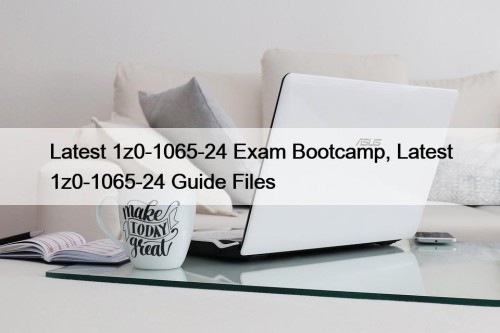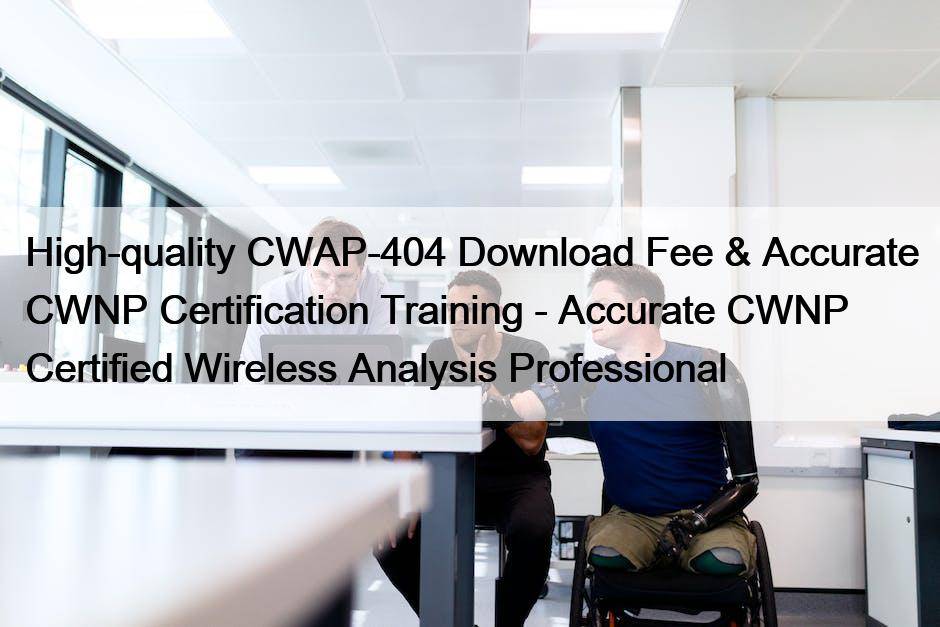Most Popular
 Trustable CIPS Guide L6M2 Torrent and the Best Accurate New L6M2 Exam Fee
Trustable CIPS Guide L6M2 Torrent and the Best Accurate New L6M2 Exam Fee
If you come to our website to choose our L6M2 ...
 Latest 1z0-1065-24 Exam Bootcamp, Latest 1z0-1065-24 Guide Files
Latest 1z0-1065-24 Exam Bootcamp, Latest 1z0-1065-24 Guide Files
With the pass rate is 98.65% for 1z0-1065-24 learning materials, ...
 Study Anywhere, Anytime With 1Z0-1057-23 PDF Dumps File
Study Anywhere, Anytime With 1Z0-1057-23 PDF Dumps File
If you are a workman and you want to pass ...



High-quality CWAP-404 Download Fee & Accurate CWNP Certification Training - Accurate CWNP Certified Wireless Analysis Professional

P.S. Free 2025 CWNP CWAP-404 dumps are available on Google Drive shared by Exam4PDF: https://drive.google.com/open?id=1tj-I2QT0tcJL8ZIJSJ7rsG1geZCbG-T_
Many users report to us that they are very fond of writing their own notes while they are learning. This will enhance their memory and make it easier to review. Our CWAP-404 exam questions have created a PDF version of the CWAP-404 practice material to meet the needs of this group of users. You can print the PDF version of the CWAP-404 learning guide so that you can carry it with you. As long as you have time, you can take it out to read and write your own experience.
CWNP CWAP-404 Exam Topics:
| Section | Objectives |
|---|---|
Protocol Analysis - 15% | |
| Capture 802.11 frames using the appropriate methods | - Select capture devices
- Install monitor mode drivers |
| Understand and apply the common capture configuration parameters available in protocol analysis tools | - Save to disk - Packet slicing - Event triggers - Buffer options - Channels and channel widths - Capture filters - Channel scanning and dwell time |
| Analyze 802.11 frame captures to discover problems and find solutions | - Use appropriate display filters to view relevant frames and packets - Use colorization to highlight important frames and packets - Configure and display columns for analysis purposes - View frame and packet decodes while understanding the information shown and applying it to the analysis process - Use multiple adapters and channel aggregation to view captures from multiple channels - Implement protocol analyzer decryption procedures - View and use a capture’s statistical information for analysis - Use expert mode for analysis - View and understand peer maps as they relate to communications analysis |
| Utilize additional tools that capture 802.11 frames for analysis and troubleshooting | - WLAN scanners and discovery tools - Protocol capture visualization and analysis tools - Centralized monitoring, alerting, and forensic tools |
| Ensure appropriate troubleshooting methods are used with all analysis types | - Define the problem - Determine the scale of the problem - Identify probable causes - Capture and analyze the data - Observe the problem - Choose appropriate remediation steps - Document the problem and resolution |
Spectrum Analysis - 10% | |
| Capture RF spectrum data and understand the common views available in spectrum analyzers | - Install, configure, and use spectrum analysis software and hardware - Capture RF spectrum data using handheld, laptop-based, and infrastructure spectrum capture solutions - Understand and use spectrum analyzer views
|
| Analyze spectrum captures to identify relevant RF information and issues | - RF noise floor in an environment - Signal-to-Noise Ratio (SNR) for a given signal - Sources of RF interference and their locations - RF channel utilization - Non-Wi-Fi transmitters and their impact on WLAN communications - Overlapping and non-overlapping adjacent channel interference - Poor performing or faulty radios |
| Analyze spectrum captures to identify various device signatures | - Identify various 802.11 PHYs
- Identify non-802.11 devices based on RF behaviors and signatures
|
| Use centralized spectrum analysis solutions | - AP-based spectrum analysis - Sensor-based spectrum analysis |
PHY Layers and Technologies - 10% | |
| Understand and describe the functions of the PHY layer and the PHY protocol data units (PPDUs) | - DSSS (Direct Sequence Spread Spectrum) - HR/DSSS (High Rate/Direct Sequence Spread Spectrum) - OFDM (Orthogonal Frequency Division Multiplexing) - ERP (Extended Rate PHY) - HT (High Throughput) - VHT (Very High Throughput) - HE (High Efficiency)
|
| Apply the understanding of PHY technologies, including PHY headers, preambles, training fields, frame aggregation, and data rates, to captured data | |
| Identify and use PHY information provided within pseudo-headers in protocol analyzers | - Pseudo-Header formats
- Key pseudo-header content
|
| Recognize the limits of protocol analyzers to capture PHY information including NULL data packets and PHY headers | |
| Use appropriate capture devices based on proper understanding of PHY types | - Supported PHYs - Supported spatial streams |
2025 CWAP-404 – 100% Free Download Fee | Latest CWAP-404 Answers Free
A good brand is not a cheap product, but a brand that goes well beyond its users' expectations. The value of a brand is that the CWAP-404 exam questions are more than just exam preparation tool -- it should be part of our lives, into our daily lives. Do this, therefore, our CWAP-404 question guide has become the industry well-known brands, but even so, we have never stopped the pace of progress, we have been constantly updated the CWAP-404 real study dumps. The most important thing is that the CWAP-404 exam questions are continuously polished to be sold, so that users can enjoy the best service that our products bring. Our CWAP-404 real study dumps provide users with comprehensive learning materials, so that users can keep abreast of the progress of The Times.
CWNP Certified Wireless Analysis Professional Sample Questions (Q81-Q86):
NEW QUESTION # 81
You have implemented centralized, infrastructure-based spectrum analysis.
The Aps are configured to perform spectrum analysis in an ad-hoc manner and will go offline as Aps to perform this duty when needed.
What unique method of spectrum analysis monitoring is provided by this solution that is not typically available in a laptop-based analyzer?
- A. Real-time FFT
- B. Band selection
- C. Web-based viewing
- D. RBW adjustments
Answer: D
NEW QUESTION # 82
Shown is a screenshot of a wireless protocol analyzer displaying the decode information for a single 802.11 encrypted data + CF-Poll frame. The infrastructure BSS on which this information was captured is using WEP and this particular frame was sent from a client station (STA) to an access point (AP).
As a protocol analyst, how would you explain the existence of this frame on the wireless medium given the information in the decode?
- A. The access point is operating as a repeater, and clients must poll repeater access points in order to transmit data frames through them.
- B. The IEEE 802.11 network is using both version 1 and version 2 protocols simultaneously. This unexpected frame is from the version 2 protocol set.
- C. The frame was misinterpreted because of insufficient information received by the analyzer due to frame corruption.
- D. The frame was sent by a client station that does not comply with IEEE HR/DSSS standard to an access point that is Wi-Fi certified.
Answer: C
NEW QUESTION # 83
Finish the statement. It is possible to distinguish between _______and ______20 MHz transmissions when looking at an FFT plot.
- A. HT and VHT
- B. OFDM and HT
- C. ERP and VHT
- D. HR/DSSS and ERP
Answer: B
Explanation:
It is possible to distinguish between OFDM 20 MHz transmissions and HT 20 MHz transmissions when looking at an FFT plot. OFDM and HT are two different modulation schemes used by
802.11 WLANs. OFDM is used by legacy 802.11a/g devices, while HT is used by newer
802.11n/ac devices. OFDM and HT have different spectral characteristics that can be observed on an FFT plot. OFDM transmissions have a flat spectrum with sharp edges, while HT transmissions have a tapered spectrum with rounded edges. This is because HT uses guard intervals and cyclic prefixes to reduce inter-symbol interference and improve performance. The other options are not correct, as they do not describe different modulation schemes or channel widths that can be distinguished on an FFT plot.
NEW QUESTION # 84
ABC Company requires the ability to identify and quickly locate rogue devices. ABC has chosen an overlay WIPS solution with Wi-Fi sensors that use dipole antennas to perform this task. No other sensors are included. Use your knowledge of location tracking techniques to answer the question.
Which one of the following location methods is not available in the described system?
- A. Trilateration of RSSI measurements
- B. Time Difference of Arrival (TDoA)
- C. RF Fingerprinting
- D. GPS Positioning
Answer: D
NEW QUESTION # 85
What should the To DS and From DS flags be to set to in an Association Response frame?
- A. To DS - 1, From DS = 0
- B. To DS = 1, From DS = 1
- C. To DS - 0, From DS = 0
- D. To DS = 0, From DS = 1
Answer: C
Explanation:
Explanation
The To DS and From DS flags should be set to 0 in an Association Response frame. An Association Response frame is a type of management frame that is transmitted by an AP to accept or reject an association request from a STA. The To DS (To Distribution System) and From DS (From Distribution System) flags are two bits in the Frame Control field of the MAC header that indicate whether a frame is destined for or originated from the DS (Distribution System), which is a system that connects multiple BSSs together. The To DS and From DS flags can have four possible combinations: 00, 01, 10, or 11. For an Association Response frame, which is sent from an AP to a STA within a BSS, both flags should be set to 0. References: [Wireless Analysis Professional Study Guide CWAP-404], Chapter 5: 802.11 MAC Sublayer, page 121-122
NEW QUESTION # 86
......
The web-based Certified Wireless Analysis Professional (CWAP-404) practice exam can be accessed through online browsing anywhere just with a stable internet connection. So the applicants can take the CWAP-404 practice exam with ease for the preparation for the CWAP-404 Exam. All browsers and operating systems support the web-based CWAP-404 practice exam. Users can access it without installing or downloading any excessive plugins or software.
CWAP-404 Answers Free: https://www.exam4pdf.com/CWAP-404-dumps-torrent.html
- Valid Braindumps CWAP-404 Questions 😦 CWAP-404 Reliable Test Experience 🥽 Reliable CWAP-404 Test Guide 😐 Search on ▛ www.examsreviews.com ▟ for ➤ CWAP-404 ⮘ to obtain exam materials for free download ⚠Valid CWAP-404 Exam Prep
- CWNP CWAP-404 Download Fee | Easy To Study and Pass Exam at first attempt - CWAP-404: Certified Wireless Analysis Professional 🪁 Search for { CWAP-404 } and download it for free immediately on ▷ www.pdfvce.com ◁ 🦥CWAP-404 Exam Questions Vce
- Valid Braindumps CWAP-404 Questions 🏞 CWAP-404 Exam Questions Vce 🦺 CWAP-404 New Exam Braindumps 🔢 Search for ➠ CWAP-404 🠰 and download it for free immediately on ▶ www.pass4leader.com ◀ 👛New CWAP-404 Test Forum
- Preparing for CWNP CWAP-404 PDF Exam Questions In Short Time 😋 Search for 【 CWAP-404 】 and download it for free on 【 www.pdfvce.com 】 website 🐈Practice CWAP-404 Tests
- Certified Wireless Analysis Professional actual exam torrent - CWAP-404 dumps will facilitate exam success 🤑 The page for free download of ➡ CWAP-404 ️⬅️ on ➥ www.torrentvce.com 🡄 will open immediately 🏉Pass4sure CWAP-404 Dumps Pdf
- CWAP-404 New Exam Braindumps 💹 New CWAP-404 Test Forum 🖼 New CWAP-404 Test Forum 😶 Simply search for ⇛ CWAP-404 ⇚ for free download on 【 www.pdfvce.com 】 🕶CWAP-404 Vce Files
- Valid CWAP-404 Exam Prep 🎭 Reliable CWAP-404 Exam Price 😳 CWAP-404 Test Question 🐗 Search for ⮆ CWAP-404 ⮄ and easily obtain a free download on “ www.prep4pass.com ” 💋CWAP-404 New Exam Braindumps
- CWAP-404 Valid Test Dumps 🏦 CWAP-404 Vce Files 🚻 Pass4sure CWAP-404 Dumps Pdf 🕍 Search for ⇛ CWAP-404 ⇚ and easily obtain a free download on ▷ www.pdfvce.com ◁ 🧺New CWAP-404 Exam Answers
- Reliable CWAP-404 Test Guide 🤯 Pass4sure CWAP-404 Dumps Pdf 🤧 New CWAP-404 Test Practice 💧 Easily obtain free download of 《 CWAP-404 》 by searching on ✔ www.examsreviews.com ️✔️ 📏Valid CWAP-404 Test Objectives
- CWAP-404 Reliable Exam Voucher 😼 CWAP-404 Vce Files 🚤 CWAP-404 Vce Files 🎵 Easily obtain ⇛ CWAP-404 ⇚ for free download through 《 www.pdfvce.com 》 🦛Valid Braindumps CWAP-404 Questions
- CWNP CWAP-404 Download Fee | Easy To Study and Pass Exam at first attempt - CWAP-404: Certified Wireless Analysis Professional 🥋 The page for free download of ➽ CWAP-404 🢪 on ( www.passcollection.com ) will open immediately 🍅New CWAP-404 Exam Answers
- CWAP-404 Exam Questions
- course.techmatrixacademy.com robinskool.com 47.121.119.212 www.education.indiaprachar.com iban天堂.官網.com jsfury.com lms.quannnt.com cllwbcs.com www.tektaurus.com lineage9527.官網.com
What's more, part of that Exam4PDF CWAP-404 dumps now are free: https://drive.google.com/open?id=1tj-I2QT0tcJL8ZIJSJ7rsG1geZCbG-T_
Tags: CWAP-404 Download Fee, CWAP-404 Answers Free, New Braindumps CWAP-404 Book, CWAP-404 Best Vce, New CWAP-404 Test Cram